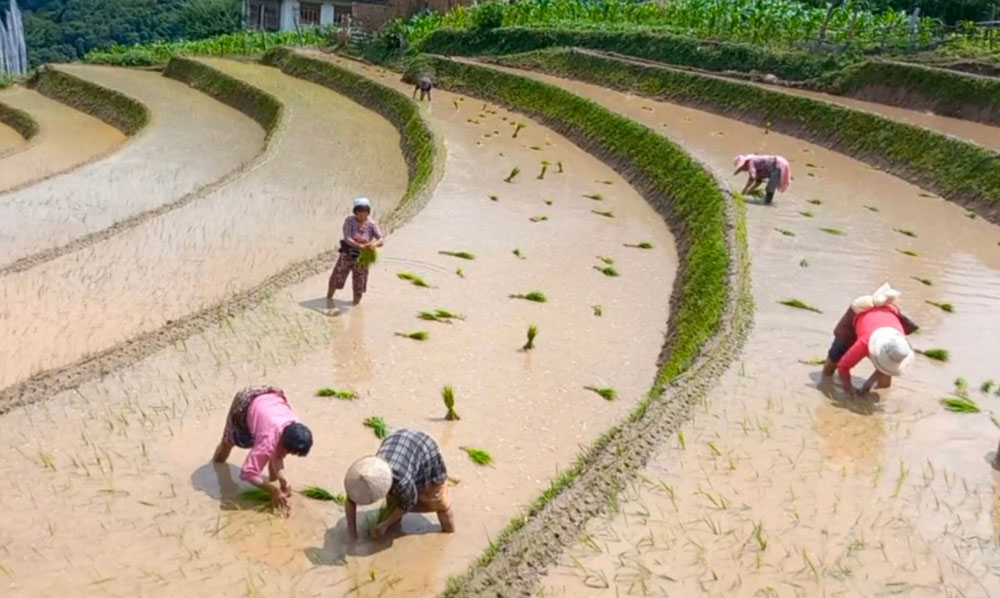
The villagers of Tshankhardung in Trashiyangtse are making the most of their day, attending to their farmlands and taking a well-deserved mid-morning break. Among them, Jatshola and his friends are particularly content this year as they are on track to cultivate a whopping 200 acres of their land.
This accomplishment marks a significant shift for Jatshola, who not too long ago faced the challenge of insufficient water for cultivating his desired amount of land, all due to the presence of an unpaved village irrigation canal. However, those days are now a distant memory, and Jatshola is now a happier and more productive farmer.
Reflecting on the hardships endured over the past years, particularly the scarcity of irrigation water in the village, Jatshola recalls, “We cultivated less land because of water seepage, which led to water shortage. I could cultivate only half or one acre of my land every year in the past.”
The transformation in Jatshola’s fortunes, and that of numerous other farmers, can be attributed to the De-suung Water Project, which entailed the paving of the village’s irrigation canal earlier this year.
The construction of the Gochu and Barchu canals has undeniably become a boon for farmers residing in Pang-Lhauzhing and Maenchhu-Tsangdhung chiwogs.
“The unlined canal was inefficient; it absorbed a lot of the water, and it took almost three hours to bring water to our farms,” says Jatshola. “Now water reaches our farms in half an hour, and water wastage is not a problem anymore.”
Before the canal was constructed, a substantial portion of the water would be absorbed into its earthen bed, leaving only a fraction to reach the farms.
Phuntsho Wangmo, a villager of Tshankhardung, adds, “I could only cultivate a few portions of farmland of the one acre of land in the village due to poor irrigation in the past. Since the canal was improved and the water began to reach my land, I am able to cultivate the entire one acre of land.”
The benefits derived from the improved irrigation canal extend far beyond increased agricultural productivity. The enhanced canal has also translated into considerable time and energy savings previously spent on canal maintenance.
Villagers recount how they used to restore the canal each year to ensure water could reach their farmlands.
“Forty to fifty villagers had to clear the canal each winter and prepare it for the upcoming summer,” says Phuntsho. “In the event of early summer flooding, the canal often required multiple cleanings and had to be restored per year, taking away the time and energy farmers could spend on their crops.”
With a higher flow of water now possible, farmers can cultivate larger areas of their farmlands. “We are relieved now. Whenever water is needed, we can irrigate and direct the water to others if we have excess,” shares a contented farmer.
“The villagers are already witnessing an improvement in their farming since the irrigation canal was upgraded,” Namgay, tshogpa of Maenchhu-Tsangdung. “The project has brought positive changes and improved the irrigation water system, making it much better than before.”
While farmers typically rely on small irrigation water sources, the recent improvement has rendered it sufficient. “Some people who had given up and left their land fallow have now returned to cultivate paddy.”
Previously, the farmlands in the village would often remain uncultivated, resulting in a less vibrant landscape. However, armed with a better irrigation system and enhanced knowledge, most villagers now embrace the greenery of their flourishing farmlands.
Ensuring water throughout the year
Every year, farmers in the two chiwogs had to endure the waiting game during the paddy cultivation season, as they would irrigate their fields in turns. At times, the paddy fields would dry up while farmers awaited their turn.
The positive impact of the improved irrigation canal can be witnessed throughout the village, evident in the increased acreage under cultivation.
Tashi, a farmer from Menchu, shares his disbelief at finally having enough water for irrigation during the fall season. Such a scenario was previously unheard of until the recent improvements were made to the irrigation canal.
“We are relieved now. All we need to do is to go to the water source and direct the water to the canal,” says Tashi. “If we do not want water in a certain direction, we simply close the concerned hatch, and the water diverts to another.”












